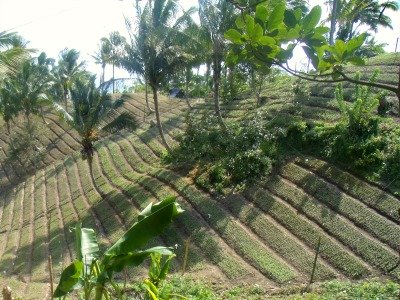What is Contour Farming?
Contour farming is a technology, a practice, or a system in sloping agricultural lands whereby crop rows are oriented perpendicular to or across the slope of the land.
Both in short-maturing annual crops, e.g., corn, and in perennial crops, e.g., coconut, the same rule applies.
Now there are special terms for relevant farming practices such as contour-hedgerow farming, contour-hedgerow-strip farming, and sloping agricultural land technology or SALT.
Planting in contour lines is the rule in sloping lands because if otherwise, the rows are in lines running from top to bottom, and the soil will be eroded downhill by wind and water.
But that is not all.
In heavy rains, the surface runoff will cascade downward along the rows if there are furrows or in between rows, and in just a very short time the farm will reveal a unique landscape where there are canals going downhill with soil and seeds or plants collected at the base.
With time these canals will turn into creeks.
The farm anyway will be impossible to plow or furrow upward or downward or in a diagonal direction even with the use of any draft animal.

The impossibility should be more apparent to a farmworker if, for example, sowing of corn or peanut is to be done downhill.
Even if furrows have been made, the far distance from the hand of the sower to the bottom of the furrow will make it impossible to evenly space the seeds.
Expect also that the seeds hitting the ground will roll downward.
The distance can be shortened, but that will necessitate stooping downward with the risk of the sower tumbling downward himself.
Uphill planting would be easy, but there will be too much energy expended. Imagine doing the U-turn several times and that’s it, the task is impossible.
Contour farming, therefore, is also for convenience and to make certain farm operations possible. It is borne out of common sense.
Farm operations such as slashing, plowing, planting, fertilizing, weeding, and spraying, are done following a path with more or less even elevation.
Similarly, any man would prefer to walk on a flat trail.
Even the no-read-no-write traditional farmers in communities with rolling topography know contour farming well, but minus the English technical term.
They may not know either what an A-Frame or any other contour line locator is, but look at their farms and how they plant corn and you will realize that they deserve to be treated as consultants. I do.
My farmhand friends may do it if I command them to plant corn uphill and downhill, but it will just be for the high pay – and for the big laugh.
They will have their day, laughing hysterically until their mouths tear apart while they work and the experience will be the talk of the community until many years to come.
I will surely become an instant and infinitely the craziest celebrity, which I do not want.
Contour Lines in Contour Farming
The most distinguishing feature of contour farming is the contour line.
It is an imaginary line perpendicular to the slope of a farm and is equivalent to the row in the check-row pattern of planting.
The line or row traverses the farm from one boundary to the opposite across the slope regardless of the aspect of the slope, i.e., whether east-facing, west-facing, and so on.
Several to many such lines are formed on the face of the slope depending on the distance from top to bottom and the row-to-row distance. Line-to-line distances may vary with slope.
Viewed from opposite the face of the slope, all lines will appear straight.
However, on top view, the lines may either be straight, curved like the outside of a sphere or curved irregularly downward or upward depending on the presence of low- and high-lying surfaces on the face of the slope.
These lines define the placement of perennial crops or hedges or terraces in contour farming.
Theoretically, all points on any same line are assumed to lie on the same vertical elevation or altitude, for example, 400 meters above sea level (masl).
As in rice terraces, all walls or dikes must be horizontally leveled otherwise water will spill at any low section.
